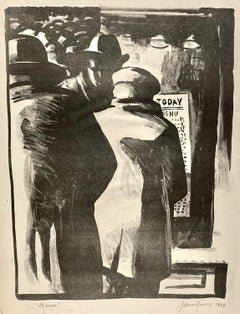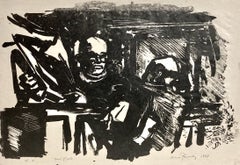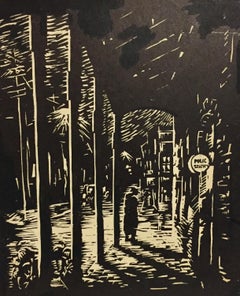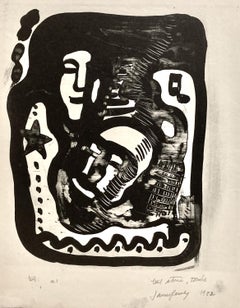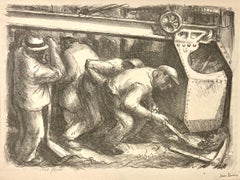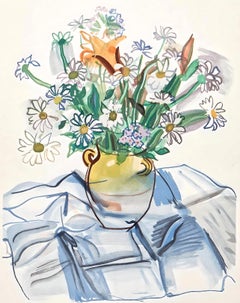James Penney Prints and Multiples
to
1
8
6
2
8
Overall Height
to
Overall Width
to
1
7
5
3
3
2
1
1
1
1
1
1
1
1
1
1
1
1
8
1
6
9
1,001
734
670
636
7
1
Artist: James Penney
James Penney, Corridor
By James Penney
Located in New York, NY
James Penney was widely known for his New Yorker covers as well as his paintings and prints.
Penney was from Saint Joseph, Missouri. He trained in NY...
Category
1930s Ashcan School James Penney Prints and Multiples
Materials
Lithograph
James Penney, Menu
By James Penney
Located in New York, NY
James Penney was widely known for his New Yorker covers as well as his paintings and prints.
Penney was from Saint Joseph, Missouri. He trained in NYC at the Art Students League. Th...
Category
1930s Ashcan School James Penney Prints and Multiples
Materials
Lithograph
James Penney, Point of Order
By James Penney
Located in New York, NY
James Penney was widely known for his New Yorker covers as well as his paintings and prints.
Penney was from Saint Joseph, Missouri. He trained in NYC at the Art Students League. The New-York Historical Society and the Library of Congress both have collections of his work.
Signed, titled, and dated.
Especially like the test marks at the lower right and the way the lawyer is leaning/relaxing on the judge...
Category
Mid-20th Century Ashcan School James Penney Prints and Multiples
Materials
Lithograph
James Penney, Police Station, Lawrence, Kansas
By James Penney
Located in New York, NY
James Penney was widely known for his New Yorker covers as well as his paintings and prints.
Penney was from Saint Joseph, Missouri. He trained in NYC at the Art Students League. Th...
Category
1920s Ashcan School James Penney Prints and Multiples
Materials
Linocut
James Penney, Test Stone, Touche
By James Penney
Located in New York, NY
James Penney was widely known for his New Yorker covers as well as his paintings and prints.
Penney was from Saint Joseph, Missouri. He trained in NYC at the Art Students League. The New-York Historical Society and the Library of Congress both have collections of his work.
Signed, titled, and dated, and annotated 'Test #1' in pencil.
Note entirely sure what's going on here...
Category
1930s Ashcan School James Penney Prints and Multiples
Materials
Lithograph
James Penney, Street Pavers (New York City)
By James Penney
Located in New York, NY
James Penney was widely known for his New Yorker covers as well as his paintings and prints. This lithograph of male laborers, Street Pavers, remi...
Category
1930s Ashcan School James Penney Prints and Multiples
Materials
Lithograph
James Penney, Central Park (NYC) (Also titled Park -- Spring)
By James Penney
Located in New York, NY
James Penney was widely known for his New Yorker covers as well as his paintings and prints. This lithograph shares the happy joy of warm days in the park with people on benches and ...
Category
1930s Ashcan School James Penney Prints and Multiples
Materials
Lithograph
James Penney, Symbols: Leader, Intellectual, Worker
By James Penney
Located in New York, NY
James Penney was widely known for his New Yorker covers as well as his paintings and prints. Although dating from 1932, this composition recalls New Deal Murals.
Category
1930s Modern James Penney Prints and Multiples
Materials
Lithograph
Related Items
IL CASANOVA "Il Teatro de Dresda" Signed Lithograph, 1976 Italian Film, Theater
By Federico Fellini
Located in Union City, NJ
''Il Casanova - il teatro de Dresda'' (Casanova in the Theatre of Dresden)
'Il Casanova–il teatro di Dresda,' is a fine art limited edition color lithograp...
Category
1980s Contemporary James Penney Prints and Multiples
Materials
Lithograph
Dufy, Bouquet, Vacances forcées (after)
By Raoul Dufy
Located in Auburn Hills, MI
Lithograph on papier bouffant des Papeteries de Casteljoux paper. Unsigned and unnumbered, as issued. Good condition. Notes: From the folio, Vacances forcées 1970. Published by Éditi...
Category
1970s Modern James Penney Prints and Multiples
Materials
Lithograph
BAR MITZVAH AT THE WESTERN WALL (JUDAICA ART)
By Amram Ebgi
Located in Aventura, FL
Lithograph with foil stamping and embossing on paper. Hand signed and numbered by the artist. From the edition of 200.
Artwork is in excellent condition. Certificate of authenticit...
Category
Late 20th Century Contemporary James Penney Prints and Multiples
Materials
Foil
CUBIST ROOM (PICASSO)
By Ferjo, Fernando de Jesus Oliveira
Located in Aventura, FL
Lithograph in colors on paper. Hand signed and numbered by the artist. AP edition. Sheet size 23.5 x 11.25 inches. Image size approx 19.5 x 9.75 inches.
Artwork is in excellen...
Category
21st Century and Contemporary Surrealist James Penney Prints and Multiples
Materials
Lithograph, Paper
Women from Salt River, Lithograph by R.C. Gorman
By R.C. Gorman
Located in Long Island City, NY
An original hand-signed lithograph by Native American artist, RC Gorman. Numbered AP 15.
Category
1990s Folk Art James Penney Prints and Multiples
Materials
Lithograph
French Vintage Modern Art Deco Nitrolian Fast Drying Paint Promotional Poster
By Leonetto Cappiello
Located in Houston, TX
Modern art deco promotional poster by artist and illustrator Leonetto Cappiello. The work features a man using Nitrolian paint to paint a set of stairs as a woman walks down. The pa...
Category
1920s Modern James Penney Prints and Multiples
Materials
Lithograph
H 40 in W 30.13 in D 1.5 in
Two Sages, Peter Max
By Peter Max
Located in Fairfield, CT
Artist: Peter Max (1937)
Title: Two Sages
Year: 2000
Edition: 421/500, plus proofs
Medium: Lithograph on Lustro Saxony paper
Size: 7.25 x 8.25 inches
Condition: Excellent
Inscription...
Category
Early 2000s Pop Art James Penney Prints and Multiples
Materials
Lithograph
FIVE MUSICIANS (JUDAICA ART)
By Amram Ebgi
Located in Aventura, FL
Embossed lithograph with foil stamping on paper. Hand signed and numbered by the artist. From the edition of 750.
Artwork is in excellent condition. Certificate of authenticity in...
Category
Late 20th Century Contemporary James Penney Prints and Multiples
Materials
Foil
'Financial District', New York City — 1930s American Modernism
By Howard Norton Cook
Located in Myrtle Beach, SC
Howard Cook, 'Financial District', lithograph, 1931, edition 75, Duffy 155. A fine, richly-inked impression, on cream wove paper, the full sheet with wide margins (2 3/4 to 5 5/8 inches), in excellent condition. Image size 13 5/16 x 10 3/8 inches (338 x 264 mm); sheet size 23 x 16 inches (584 x 406 mm). Matted to museum standards, unframed.
Literature: 'American Master Prints from the Betty and Douglas Duffy Collection', the Trust for Museum Exhibitions, Washington, D.C., 1987.
Collections: Crystal Bridges Museum of American Art, Library of Congress, Metropolitan Museum of Art, Philadelphia Museum of Art, Smithsonian American Art Museum.
ABOUT THE ARTIST
Howard Norton Cook (1901-1980) was one of the best-known of the second generation of artists who moved to Taos. A native of Massachusetts, he studied at the Art Students League in New York City and at the Woodstock Art Colony. Beginning his association with Taos in 1926, he became a resident of the community in the 1930s. During his career, he received two Guggenheim Fellowships and was elected an Academician in the National Academy of Design. He earned a national reputation as a painter, muralist, and printmaker.
Cook’s work in the print mediums received acclaim early in his career with one-person exhibitions at the Denver Art Museum (1927) and the Museum of New Mexico (1928). He received numerous honors and awards over the years, including selection in best-of-the-year exhibitions sponsored by the American Institute of Graphics Arts, the Brooklyn Museum, the Society of American Etchers, and the Philadelphia Print Club. His first Guggenheim Fellowship took him to Taxco, Mexico in 1932 and 1933; his second in the following year enabled him to travel through the American South and Southwest.
Cook painted murals for the Public Works of Art Project in 1933 and the Treasury Departments Art Program in 1935. The latter project, completed in Pittsburgh, received a Gold Medal from the Architectural League of New York. One of his most acclaimed commissions was a mural in the San Antonio Post Office in 1937.
He and Barbara Latham settled in Talpa, south of Taos, in 1938 and remained there for over three decades. Cook volunteered in World War II as an Artist War Correspondent for the US Navy, where he was deployed in the Pacific. In 1943 he was appointed Leader of a War Art Unit...
Category
1930s American Modern James Penney Prints and Multiples
Materials
Lithograph
Ruins of Central City, Vintage 1935 Framed Colorado Modernist Landscape
By Vance Kirkland
Located in Denver, CO
Vintage lithograph titled "Ruins of Central City 31/70" is a modernist landscape with decaying buildings and mountains by Vance Hall Kirkland, from 1935. Presented in a custom black frame with archival materials, outer dimensions measure 25 ⅞ x 29 ⅜ x ⅝ inches. Image sight size is 14 x 17 ¾ inches.
Painting is clean and in very good vintage condition - please contact us for a detailed condition report.
Provenance: Private collection, Denver, Colorado
Expedited and international shipping is available - please contact us for a quote.
About the Artist:
Variously referred to as the "Father of Modern Colorado Painting", "Dean of Colorado Artists", and "Colorado’s pre-eminent artist," Kirkland was an inventive, visionary painter who spent fifty-two years of his fifty-four-year career in Denver. Of the approximately 1,200 paintings he created, about 550 from the first half of his career (1927-1953) are water-based media: acquarelle, gouache, casein and egg tempera, with a few oils. In the latter half of his career (1953-1981) he used oil and his unique oil and water mixture. He also produced five hundred drawings and some ten prints, mostly lithographs on stone, while also engaged in teaching full-time for most of the period.
To show people "something they have never seen before and new ways to look at things," he felt he needed to preserve his artistic freedom. Consequently, he chose to spend his entire professional career in Denver far removed from the established American art centers in the East and Midwest. "By minding my own business and working on my own," he said, "I think it was possible to develop in this part of the country… I’ve developed my kind of work [and] I think my paintings are stronger for having worked that way." The geographical isolation resulting from his choice to stay in Colorado did not impede his creativity, as it did other artists, but in fact contributed to his unique vision.
The son of a dentist, who was disappointed with his [son’s] choice of art as a career, Kirkland flunked freshman watercolor class in 1924 at the Cleveland School of Art (now the Cleveland Institute of Art) for putting colors into his landscapes that did not exist in nature and for competing colors. Not dissuaded, he won first prize for his watercolors in his junior and senior years. [While in Cleveland,] he studied with three influential teachers. Henry Keller, included in the prestigious New York Armory Show in 1913, introduced him to designed realism which he later used in his Colorado landscapes in the 1930s and 1940s. His other teachers were Bill Eastman, who studied with Hans Hofmann and appreciated all the new movements in modern art, and Frank Wilcox, a fine watercolorist.
While a student at the Cleveland School of Art, Kirkland concurrently took liberal arts courses at Western Reserve and the Cleveland School of Education and taught two freshman courses in watercolor and design, receiving his diploma in painting from the school in 1927 by doing four years of work in three. The following year he received a Bachelor of Education in Art degree from the same institution.
In 1929 he assumed the position of founding director of the University of Denver’s School of Art, originally known as the Chappell School of Art. He resigned three years later when the university reneged on its agreement to grant its art courses full recognition toward a Bachelor of Arts degree. His students prevailed on him to continue teaching, resulting in the Kirkland School of Art which he opened in 1932 at 1311 Pearl Street in Denver. The building, where he painted until his death in 1981, formerly was the studio of British-born artist, Henry Read, designer of the City of Denver Seal and one of the original thirteen charter members of the Artists’ Club of Denver, forerunner of the Denver Art Museum. The Kirkland School of Art prospered for the next fourteen years with its courses accredited by the University of Colorado Extension Center in Denver.
The teaching income from his art school and his painting commissions helped him survive the Great Depression. The U.S. Treasury Department’s Section of Fine Arts commissioned from him two post office murals, Cattle Roundup (1938, Eureka, Kansas), and Land Rush (1940, Sayre, Oklahoma). He also did murals for several Denver clients: the Gerald Hughes mansion (1936, later demolished), Arthur Johnson home (1936-37, Seven Drinks of Man), Albany Hotel (1937, later demolished), Neustetter’s Department Store (1937, "History of Costume," three of five saved in 1987 before the building interior was demolished in advance of its condo conversion), and the Denver Country Club (1945, partially destroyed and later painted over).
In 1953 the Ford Times, published by the Ford Motor Company, commissioned Kirkland along with fellow Denver artists, William Sanderson and Richard Sorby, to paint six watercolors each for the publication. Their work appeared in articles [about] Colorado entitled, "Take to the High Road" (of the Colorado Rockies) by Alicita and Warren Hamilton. Kirkland sketched the mountain passes and high roads in the area of Mount Evans, Independence Pass near Aspen, and Trail Ridge Road in Rocky Mountain National Park.
In 1946 Kirkland closed his art school when the University of Denver rehired him as director of its School of Art and chairman of the Division of Arts and Humanities. In 1957 the University gave him its highest honor – the "University Lecturer Award." When he retired in 1969 as Professor of Art Emeritus to become a full-time painter, the School of Arts was the university’s largest undergraduate department. In 1971 Governor John Love presented Kirkland the State of Colorado Arts and Humanities Award. In addition to his dual positions as artist and teacher in Denver for more than half a century, he served the Denver Art Museum as a trustee, chairman of the accessions committee, member of the exhibitions committee, curator of European and American art, and honorary curator of painting and sculpture. He also won the battle with the museum’s old guard to establish a department of modern and contemporary art. Additionally, he was one of the fifty-two founding members of the Denver Artists Guild which included most of Colorado’s leading artists who greatly contributed to the state’s cultural history.
Kirkland developed five major painting periods during his life encompassing various series with some chronological overlap: Designed Realism (1927-1944); Surrealism (1939-1954); Hard Edge Abstraction, including the Timberline Abstraction Series (1947-1957); Abstract Expressionism with four series – Nebulae, Roman, Asian, and Pure Abstractions (1951-1964); and the Dot Paintings with five series – Energy of Vibrations, Mysteries, Explosions, Forces, and Pure Abstractions (1963-1981).
Nevadaville (1931), a watercolor, belongs to Kirkland’s initial period of Designed Realism. Adapting nature by redesigning the realism he saw on location in Colorado allowed him to be "more concerned with the importance of the painting rather than the importance of the landscape." He noted that the rhythms his Cleveland teacher, Henry Keller, "found in nature created a certain movement in his paintings… [that moved] away from the static element of a lot of realistic, representational painting." Kirkland, along with fellow watercolorist Elisabeth Spalding, were some of the first Denver artists interesting themselves in Colorado’s nineteenth-century mining towns west of Denver. They offered an alternative to the overwrought cowboy and Indian subject matter of the previous generation; while the human and architectural components of the mining towns provided a welcome break from the predominant nineteenth-century landscape tradition.
Vibrations of Two Yellows in Space (1970), one of Kirkland’s small subseries of "Open Sun Paintings," occupies the final phase in his first series of dot paintings, Energy of Vibrations in Space (1963-1972). Many pieces in the series incorporate his unique mixture of oil paint and water which he developed in the early 1950s. The work in the subseries – a challenge to the viewer’s optic nerve – constitutes his contribution to the international realm of Op Art. Recalling the theory of pulsating galaxies and the universe, he used dots applied with dowels of different sizes to surround and leave round open spaces letting the gradient background show through. Because of the color contrast between the two, the "suns" either recede into the background or jump out in the foreground, creating the powerful pulsing effect.
During his lifetime he assembled on a limited budget an extensive collection of fine and decorative art and furniture. His collecting passion dated from his student days when he used his prize money from the Cleveland School of Art to purchase a watercolor by William Eastman and a now-famous set of Russian musician figures by Alexander Blazys, both of whom were his professors. After Kirkland’s death, the Denver Art Museum received a large bequest that included paintings by Roberto Matta, Gene Davis, Charles Burchfield, and Richard Anuszkiewicz (the two latter-named also alumni of the Cleveland Institute of Art); prints by Arthur B. Davies, Roberto Matta, Pablo Picasso, and Robert Rauschenberg; and a sculpture by Ossip Zadkine.
Kirkland posthumously was the subject of a television documentary, "Vance Kirkland’s Visual Language," aired on over one hundred PBS television stations (1994-96), and in 1999 a six-scene biographical ballet choreographed by Martin Friedmann with scenario provided by Hugh Grant, founder and director of the Kirkland Museum of Fine & Decorative Art in Denver. Historic Denver also posthumously honored Kirkland as part of the Colorado 100.
From 1997 to 2000 Kirkland’s solo exhibition was hosted by thirteen European museums: Fondazione Muduma, Milan; Sala Parpalló Museum Complex, València; Stadtmuseum, Düsseldorf; Frankfurter Kunstverein; Museum of Modern Art, Vienna; Kiscelli Múzeum and the Museum of Fine Arts, Budapest; Czech Museum of Fine Arts, Prague; National Museum, Warsaw; State Gallery of the Art of Poland, Sopot/Gdańsk, National Museum of Art, Kaunas, Lithuania; Latvian Foreign Art Museum, Riga; and the State Russian Museum, St. Petersburg.
Solo Exhibitions: Denver Art Museum (1930, 1935, 1939-40, 1942, 1972, 1978-retrospective, 1988, 1998); Colorado Springs Fine Arts Center (1943); Knoedler & Company, New York (1946, 1948, 1952); Pogzeba Art Gallery, Denver (1959); Galleria Schneider, Rome (1960); Birger Sandzén Memorial Gallery, Lindsborg, Kansas (1964-65,1977); Genesis Galleries, Ltd., New York (1978); Valhalla Gallery, Wichita, Kansas (1979); Inkfish Gallery, Denver (1980); Colorado State University, Fort Collins (1981- memorial exhibition); Boulder Center for the Visual Arts (1985); University of Denver, Schwayder Art Gallery (1991).
Group Exhibitions (selected): "May Show," Cleveland Museum of Art (1927-28); "Western Annuals," Denver Art Museum (1929-1957, 1964, 1966, 1968, 1971); "International Exhibition of Watercolors, Pastels, Drawings and Monotypes," Art Institute of Chicago (1930-1946); "Abstract and Surrealist American Art," Art Institute of Chicago (1947-48, traveled to ten other American museums); "Midwest Artists Exhibition," Kansas City Art Institute (1932, 1937, 1939-1942); Dallas Museum of Art (1933, 1960); San Diego Museum of Art (1941); "Artists for Victory," Metropolitan Museum of Art (1942); "United Nations Artists in America," Argent Galleries, New York (1943); "California Watercolor Society," Los Angeles County Museum (1943-1945); "Survey of Romantic Painting," Museum of Modern Art, New York (1945); New Mexico Museum of Art, Santa Fe (1945, 1951); Knoedler & Company, New York (1946-57; co-show with Max Ernest, 1950; co-show with Bernard Buffet, 1952); Joslyn Art Museum, Omaha (1948, 1956); Philbrook Art Center, Tulsa, Oklahoma (1951); "Contemporary American Painting," University of Illinois, Urbana (1952); University of Utah, Salt Lake (1952-53); Oakland Art Museum (1954-55); "Reality and Fantasy, 1900-54," Walker Art Center, Minneapolis (1954); "Art U.S.A.," Madison Square Garden, New York (1958); Roswell Museum and Art Center, New Mexico (1961); Burpee Art Museum, Rockford, Illinois (1965-68); University of Arizona Art...
Category
1930s American Modern James Penney Prints and Multiples
Materials
Paper, Lithograph
H 25.75 in W 29.5 in D 0.5 in
Gerona Cathedral urbanscape lithograph
By Josep Moscardo
Located in Barcelona, Barcelona
Josep Moscardó (1953) - Girona Cathedral
Lithograph - Hand signed
Lithograph measures 74x52 cm.
Frameless.
Numbered 121/150
Barcelona, 1953
Painter, s...
Category
1990s Post-Impressionist James Penney Prints and Multiples
Materials
Lithograph
Coney Island Beach #1
By Reginald Marsh
Located in Storrs, CT
Coney Island Beach #1. 1939. Engraving. Sasowsky catalog 191 state ii. 9 3/4 x 12 (sheet 11 1/2 x 13 7/8). Edition of 17-lifetime impressions printed by Marsh in 1939 as noted by Sas...
Category
1930s Ashcan School James Penney Prints and Multiples
Materials
Engraving
James Penney prints and multiples for sale on 1stDibs.
Find a wide variety of authentic James Penney prints and multiples available for sale on 1stDibs. You can also browse by medium to find art by James Penney in lithograph, linocut and more. Much of the original work by this artist or collective was created during the 20th century and is mostly associated with the modern style. Not every interior allows for large James Penney prints and multiples, so small editions measuring 8 inches across are available. Customers who are interested in this artist might also find the work of Fred Nagler, and George Wesley Bellows. James Penney prints and multiples prices can differ depending upon medium, time period and other attributes. On 1stDibs, the price for these items starts at $600 and tops out at $1,750, while the average work can sell for $900.

